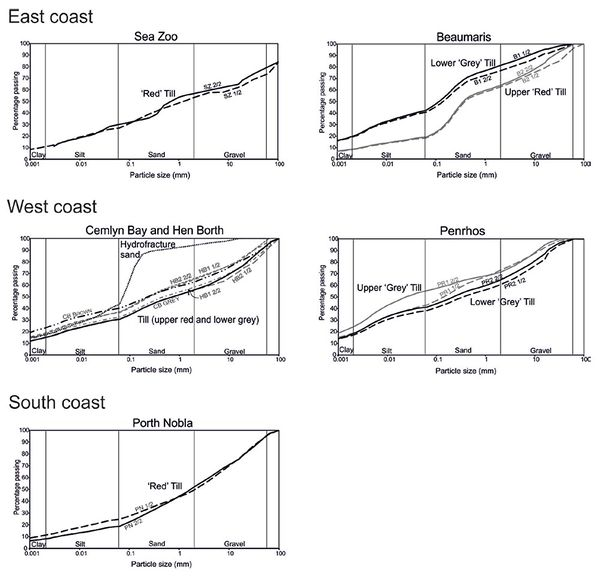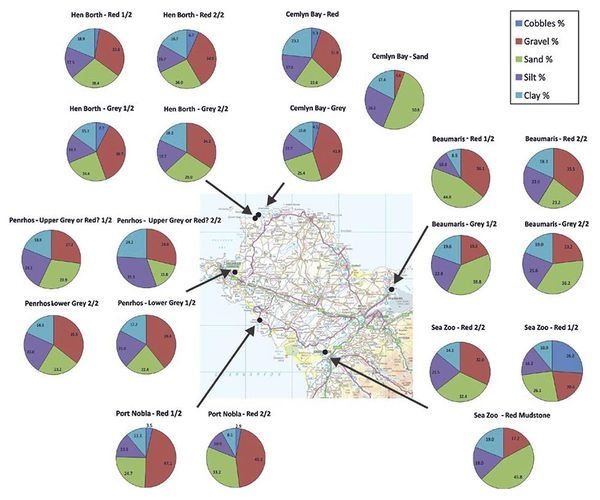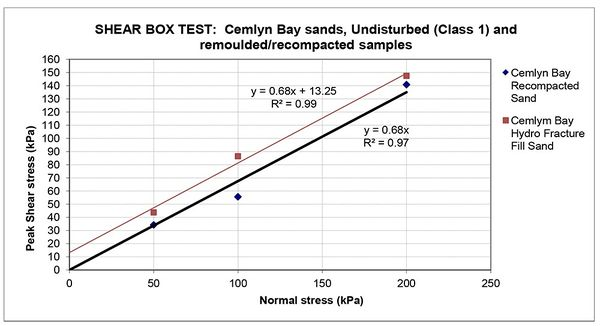OR/14/052 Results
| Boon, D, Kirkham, M, and Scheib, A. 2014. Physical properties of till deposits from Anglesey, north west Wales. British Geological Survey Internal Report, OR/14/052. |
The results of the laboratory analyses and in-situ penetrometer tests are summarised in the following section, with further details in the Appendix 2.
Particle size distribution
No. 16 particle size distribution (PSD) tests were carried out on samples collected from coastal exposures. Sample location and weights are provided in Table 1. The particle size distribution results are summarised in Table 4, grading curves are given in Figure 3 and the spatial distribution of data is summarised in Figure 4.
The till deposits on Anglesey are predominantly well-graded FINE matrix dominated soils but 4 out of the 18 tills contained less than 35% fines and are therefore COARSE soils. Variability in the proportion of the fine fraction will influence the geotechnical and hydrological properties of the till. For example, the shape of the grading curve for the upper brown till and grey till from Cemlyn Bay is almost identical however the red till contains 10% more fines making the red till a ‘coarse’ soil and the grey till a ‘fine’ soil in terms of classification for engineering purposes.
The tills from nearby Hen Borth have a similar shaped grading curve to those at Cemlyn Bay but the red till is similar in composition to the grey till. On the south coast the tills at Sea Zoo and Penrhos have similar shaped grading curves but the Penrhos tills have a slightly higher proportion of fines. The red and grey tills from Beaumaris in the east of the island are distinctly sandy and the upper red till is particularly enriched in fine to medium-grained sand.
The till at Porth Nobla is by far the coarsest, contains 19 to 25% fines, 25–33% sand, 45–47% gravel and 3% cobbles and is classified as a ‘COARSE’ soil for engineering purposes. The wide grading of the tills means their particles can become extremely tightly packed achieving high relative densities when compacted under an ice sheet. The effects of weathering include reduction in bulk density and an increase in natural moisture content and compressibility.
The ‘sand’ body found between the grey and red tills in a drumlin at Cemlyn Bay is composed of around 17% clay, 26% silt, and 50% sand (silty SAND) with a small amount (5%) of medium to coarse gravel (Figure 3, Figure 4, and Table 3) and is a FINE soil (after Anon, 1995).


Bulk density and natural moisture content
The results are summarised in Table 4, and show that bulk density of red till range from between 2.02 to 2.26 Mg/m3. Values of dry density for red till are on average 8% lower than the bulk density. Natural Moisture Content ranges between 7.3 and 9.1% for red till and 13.0% for grey till, though the latter is a single test result and so may not be representative. Bulk density values will also of course vary depending on their degree of saturation. The bulk density of the hydrofracture sand is fairly uniform and ranges from 1.92 to 2.09 Mg/m3 with a NMC of 15.3%.
| Site name | Sample ID | Particle Size % passing | |||||
| Clay | Silt | Sand | Gravel | Cobbles | % Fine fraction (clay + silt) | ||
| Hen Borth | HB1 1/2 | 18.9 | 17.5 | 28.4 | 32.6 | 2.6 | 36.4 |
| HB1 2/2 | 16.7 | 15.7 | 26.0 | 34.9 | 6.7 | 32.4 | |
| HB2 1/2 | 15.1 | 16.1 | 24.4 | 36.7 | 7.7 | 32.1 | |
| HB2 2/2 | 18.2 | 18.7 | 29.0 | 34.2 | 0 | 36.9 | |
| Beaumaris | B2 1/2 | 8.5 | 10.6 | 44.8 | 36.1 | 0 | 19.1 |
| B2 2/2 | 18.3 | 23.0 | 23.2 | 35.5 | 0 | 41.3 | |
| B1 1/2 | 19.6 | 22.8 | 38.8 | 18.8 | 0 | 42.4 | |
| B2 2/2 | 19.0 | 21.6 | 36.2 | 23.2 | 0 | 40.6 | |
| Sea Zoo | SZ (mudstone) | 19.0 | 18.0 | 45.8 | 17.2 | 0 | 37.0 |
| SZ 1/2 | 10.9 | 16.2 | 26.1 | 20.6 | 26.2 | 27.1 | |
| SZ 2/2 | 14.1 | 21.5 | 32.4 | 32.0 | 0 | 35.6 | |
| Porth Nobla | PN 1/2 | 11.1 | 13.5 | 24.7 | 47.1 | 3.5 | 24.6 |
| PN 2/2 | 8.1 | 10.8 | 33.2 | 45.1 | 2.9 | 18.9 | |
| Cemlyn Bay | Grey till | 15.0 | 15.7 | 25.4 | 41.9 | 4.1 | 30.7 |
| Red till | 23.3 | 17.0 | 22.6 | 31.8 | 5.3 | 40.3 | |
| Sand dyke | 17.4 | 26.3 | 50.8 | 5.6 | 0 | 43.7 | |
| Penrhos | PR1 1/2 | 18.8 | 24.1 | 29.9 | 27.2 | 0 | 42.9 |
| PR1 2/2 | 24.2 | 31.3 | 15.8 | 28.8 | 0 | 55.5 | |
| PR2 1/2 | 17.2 | 21.0 | 22.4 | 39.4 | 0 | 38.2 | |
| PR2 2/2 | 18.3 | 23.0 | 23.2 | 35.5 | 0 | 41.3 | |
| Sample ID | Geology Unit | Sample Type | Bulk Density, ρbulk Mg/m3 | Dry Density, ρd Mg/m3 | NMC, % |
| Cemlyn Bay A | Brown/Red Till | Ring | - | 8.5 | |
| Cemlyn Bay B | Grey Till | Ring | - | 13.0 | |
| Cemlyn Bay 7 | Weakly cemented Sand | Ring | 2.09 | ||
| Cemlyn Bay 8 | Weakly cemented Sand | Ring | 2.02 | ||
| Cemlyn Bay 9 | Weakly cemented Sand | Ring | 1.99 | ||
| Cemlyn Bay (SB 50 kPa) | Weakly cemented Sand | Tin | 2.00 | 15.3 | |
| Cemlyn Bay (SB 100 kPa) | Weakly cemented Sand | Tin | 2.05 | 15.3 | |
| Cemlyn Bay (SB 200 kPa) | Weakly cemented Sand | Tin | 1.92 | 15.3 | |
| Beaumaris 1 | Red Till | Ring | 2.04 | ||
| Beaumaris 2 | Red Till | Ring | 2.43* | 2.22* | 8.8 |
| Beaumaris 3 | Red Till | Ring | 2.26 | 2.10 | 7.3 |
| Sea Zoo 1 | Red Till | Ring | 2.16 | 1.98 | 8.3 |
| Sea Zoo 2 | Red Till | Ring | 2.21 | 2.01 | 9.1 |
| Sea Zoo 4 | Red Mudstone | Ring | 2.09 | ||
| Sea Zoo 5 | Red Till | Ring | 2.04 | ||
| Sea Zoo 6 | Red Till | Ring | 2.02 |
* gravel protruding density ring — density overestimated. SB = Shear Box sample initial ‘pre-test’ values.
Shear strength of cemented sand (Cemlyn Bay)
Peak values of Phi’ and apparent cohesion, c’, determined by direct shear tests, are summarised in Table 6, and give an effective angle of internal friction of 34 degrees. This is fairly typical of a fine sand deposit, however the sand does possess a small amount of apparent cohesion (13 kPa).
| Undisturbed sand | Remoulded, recompacted sand | |
| Apparent cohesion, c’ (kPa) | 13.3 | 0 |
| Angle of internal friction, φ’ | 34.3 | 34.3 |

Panda penetrometer results
The Panda variable energy dynamic penetrometer (Panda) test results are summarised in Table 7. Full details are included in Appendix.
| Site | Profile name | Unit | Cone resistance range (MPa) |
| Cemlyn Bay | P001 | Sand lens — NB Invalid test due to brittle soil fracture | 0.5–0.7 |
| P002 | Sand lens | 2.0–6.0 | |
| P003 | Sand lens | 2.0–5.0 | |
| P004 | Sand lens | 2.0–5.0 | |
| P005 | Grey till | 5.0–10.0 | |
| P006 | Sand lens grey till at base | 2.0–6.0 10.0 | |
| P007 | Grey till | 10.0 | |
| Beaumaris | P008 | Grey till | 5.0–7.0 |
| P009 | Grey till | 3.0–6.0 | |
| P010 | Red till | 6.0–10.0 | |
| P011 | Red till | 4.0–10.0 | |
| P012 | Red till | 3.0–6.0 | |
| Port Nobla | P014 | Red till | 7.0–10.0 |
| P015 | Red till | 2.0*–10.0 |